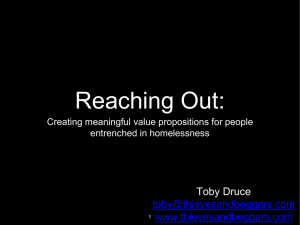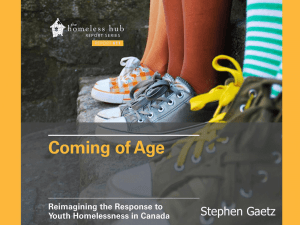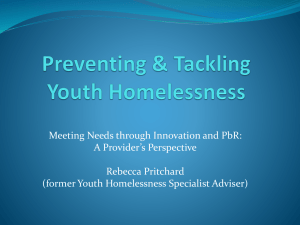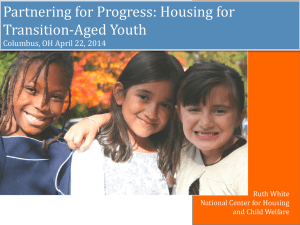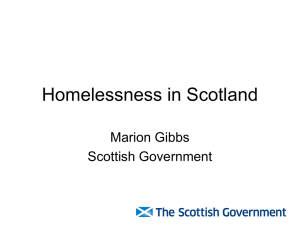Ending Homelessness: Questioning Outputs for Better Outcomes
advertisement
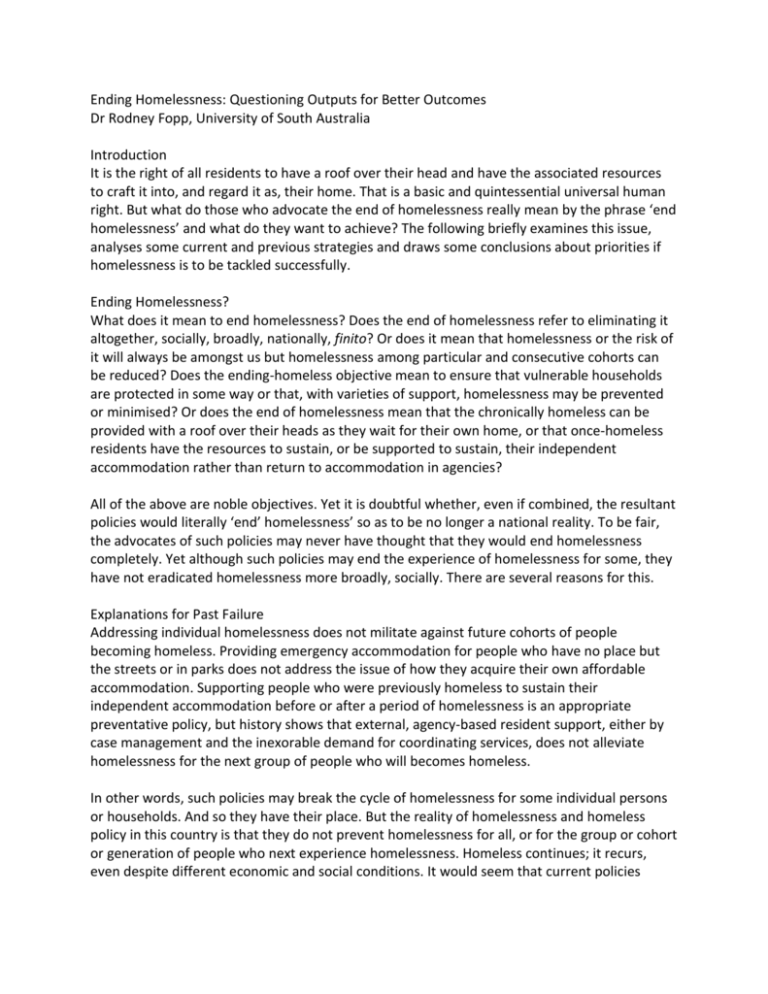
Ending Homelessness: Questioning Outputs for Better Outcomes Dr Rodney Fopp, University of South Australia Introduction It is the right of all residents to have a roof over their head and have the associated resources to craft it into, and regard it as, their home. That is a basic and quintessential universal human right. But what do those who advocate the end of homelessness really mean by the phrase ‘end homelessness’ and what do they want to achieve? The following briefly examines this issue, analyses some current and previous strategies and draws some conclusions about priorities if homelessness is to be tackled successfully. Ending Homelessness? What does it mean to end homelessness? Does the end of homelessness refer to eliminating it altogether, socially, broadly, nationally, finito? Or does it mean that homelessness or the risk of it will always be amongst us but homelessness among particular and consecutive cohorts can be reduced? Does the ending-homeless objective mean to ensure that vulnerable households are protected in some way or that, with varieties of support, homelessness may be prevented or minimised? Or does the end of homelessness mean that the chronically homeless can be provided with a roof over their heads as they wait for their own home, or that once-homeless residents have the resources to sustain, or be supported to sustain, their independent accommodation rather than return to accommodation in agencies? All of the above are noble objectives. Yet it is doubtful whether, even if combined, the resultant policies would literally ‘end’ homelessness’ so as to be no longer a national reality. To be fair, the advocates of such policies may never have thought that they would end homelessness completely. Yet although such policies may end the experience of homelessness for some, they have not eradicated homelessness more broadly, socially. There are several reasons for this. Explanations for Past Failure Addressing individual homelessness does not militate against future cohorts of people becoming homeless. Providing emergency accommodation for people who have no place but the streets or in parks does not address the issue of how they acquire their own affordable accommodation. Supporting people who were previously homeless to sustain their independent accommodation before or after a period of homelessness is an appropriate preventative policy, but history shows that external, agency-based resident support, either by case management and the inexorable demand for coordinating services, does not alleviate homelessness for the next group of people who will becomes homeless. In other words, such policies may break the cycle of homelessness for some individual persons or households. And so they have their place. But the reality of homelessness and homeless policy in this country is that they do not prevent homelessness for all, or for the group or cohort or generation of people who next experience homelessness. Homeless continues; it recurs, even despite different economic and social conditions. It would seem that current policies addressing homelessness, let alone trying to end it, have failed. And one explanation is the policies themselves. For example, the rhetoric of the erstwhile Labor Government was that the cycle of homelessness could be broken. Despite rather lame policies (as it turned it) to increase affordable housing, the policy options to reduce homelessness were largely conceived in terms of addressing individual issues rather than the structural and systemic lack of affordable housing. Thus, in the last few iterations of the Supported Accommodation Assistance Program (SAAP), and the Specialist Homelessness Services (SHS), the panacea to homelessness was more finetuning and finessing of existing programs, increasing case-management, enhanced coordination of services, and greater surveillance and intrusion in the lives of people experiencing homelessness. Moreover, one policy implication of the dominant approach was the view that clients in agencies had to achieve certain outcomes before they could be assessed as eligible for independent housing; personal change was a precondition of gaining housing. It may not have ever been stated as such, but that is what it was. One conclusion from the above analysis is that whatever the meaning of ‘ending’ homelessness, it has really only worked for some individuals. Now, nothing should minimise the importance of policies and programs for those people who have been assisted to gain their own affordable housing. But the intractable nature of homelessness in and between cohorts (in one generation and across generations or in one decade or between decades) suggests that there are factors of a systematic and deeply entrenched kind which have not been addressed and, worse, have been ignored. The recycling of homelessness over time suggests that there are entrenched structural issues at play. And the understandings of ending homelessness mentioned previously do not address such broad factors. Those who advocate ending homelessness by housing first or rapid housing tend to find novel, private ways to fund such housing. That is great for those so allocated by philanthropy. Yet it does not really address the systemic and structural factors involved in homelessness, being at risk of it and eliminating homelessness at the broader national and social level. Further, it does not meet the demand for more housing options at the affordable end of the housing market, or provide for more equitable allocation of housing. Further, those who promote more personal and interventionist approaches, as in the iterations of SAAP and SHSs, have not really tackled the lack of exit points, emphasising instead the personal issues which they allege contribute to homelessness. Both housing first and rapid rehousing, and personal interventionist, approaches have their different place, although the former merits much more attention than the latter. But neither contribute to the end of the systematic and structural unequal distribution of housing in this country and the factors which cause failure at the more affordable end of the market. Overall, given that the Housing First and Raid Re-housing approaches are relatively new in this country, the hallmark of past homelessness policy is that it concentrated on individuals rather than broader economic and social inequalities. As a generalisation, that is, as a trend for which there are exceptions, this was the approach taken by past politicians, bureaucrats, and policy makers, some in the non-government sector, and some academics, who were complicit with the mantra of the various governments of the time. A similar conclusion was made in the fourth National Evaluation into SAAP. It noted ‘an increasing international trend to begin to recognise some of the structural causes of homelessness’ while ‘in the Australian context there has been a growing emphasis by the Australian Government on the individual and personal factors that increase the risk of homelessness’ (1)(Erebus 2004: 138). Government homelessness policy has generally quarantined from its remit issues of broader economic and housing policy. In excluding homelessness policy from broader housing policy, the selected policy option tended to be a package which included advocating greater coordination of services, and adopting a deficit, residualist model of individual causation which, it was argued, needs to be addressed in order to reduce homelessness. And all this, it could be argued, has been a smokescreen obscuring the broader and deeper structural issues and market failure. Despite the mantra of the free marketeers, the housing market, with all its government support, is protected in significant ways which favour private home-ownership (for example, various home buying schemes) and the private rental market (for example, negative gearing). While they would approve of the reduction in public housing, the free marketeers insist that if there is a demand for affordable housing it will be supplied by the market. But this simply has not occurred at the more affordable end of the housing market. And it is this part of the market in which people and households experiencing homelessness must compete. In the above context several points are worth making. Several Observations Firstly, as argued, SAAP and Specialist Homelessness Services are often blamed for being part of the problem of homelessness rather than the solution. In terms of the general SAAP policy over its iterations, I reluctantly conclude that the evidence attests to that conclusion. At the overall program level, the increasing emphasis on individualist, residualist notions of causation, made SAAP part of the problem particularly when, as every National Evaluation made clear, the lack of exit points sabotaged the program. Secondly, despite this criticism, an exception is that SAAP Mark 1 (1985) prioritised rapid housing allocation. The objective of the first SAAP was to provide support to people who were homeless so that they could find their own accommodation as soon as possible. (2) In SAAP Mark 1, any accommodation and support SAAP provided was for a minimal amount of time and always with the independent housing objective in mind. It was, literally, a housing first approach to homelessness; it was, literally, a rapid housing response. I am not suggesting that SAAP Mark 1 was the same as current notions of Housing First or Rapid re-housing. I am suggesting that in broad, general terms the motivation behind SAAP Mark I emphasised the importance of rapid independent housing as a priority and the ‘support’ concentrated on gaining independent accommodation. Thirdly, one of the reasons I argue that SAAP Mark I was different from its subsequent iterations was that, by implication at least, it recognised the importance of independent, affordable secure housing as a precondition of dealing with other personal issues. Such policies are less likely to confuse personal symptoms with causes, from which many unsubstantiated assumptions about alleged causal factors are often made. Thus, for people who were homeless and have secured their own accommodation, “Home’ after homelessness is the place where issues which make people vulnerable to life’s pressures and vicissitudes, or their responses to them (such as illness), are best handled and healed. It is the secure place from which other issues can be addressed, with dignity rather than intrusion, personal agency rather than external management, in privacy rather than exposed to public gaze. Not surprisingly, and as far as I am aware, a clear preference for their own housing is also the finding of every survey of people who are homeless. Conclusion: Priorities So, then, what should we prioritise that might work to seriously reduce homeless, ensure existing housing is more secure, and that more housing is available at the affordable end of the market. (1) There should be a raft of policies and programs in proportion to the experiences of homelessness. These may include some interventionist strategies which have dominated previous and current policy. But they could also include preventative strategies, emergency accommodation for the short-term (or depending on stated need), external support for households who have exited agencies, and support toward and in secure affordable housing. But such policies should not dominate the policy response as they have since SAAP Mark II. (2) The main policy response should see the reversal of current approaches and be based on housing first and rapid re-housing responses which address systemic and structural market failure and the unequal distribution and allocation of housing in this country. And the reason is clear. Not only have the more residualist policies not worked in reducing homelessness and its risk, but the main cause of homelessness is the lack of affordable housing. Therefore, that is where most of our resources should go. (3) Public and community housing should also be revitalised. If the market cannot or will not deliver at the affordable end, governments should step in (as the free marketeers tend to want when they need ‘infrastructure’). Addressing structural inequalities (including those in the housing market), so that the first policy priority in addressing homelessness is to house people rapidly in independent accommodation, is the best way to reduce homelessness nationally. Housing funding by philanthropy is a part of that policy environment, but reducing homelessness necessitates systematic change in order to increase the supply of affordable accommodation Endnotes 1. Erebus Consulting Partners 2005, National Evaluation of the Supported Accommodation Assistance Program (SAAP IV) Final Report, Canberra, Commonwealth of Australia, May, p. 138. 2. Chesterman C 1988, Homes Away from Home, Supported Accommodation Assistance Program Review, AGPS, Canberra, pp. 10-11.
